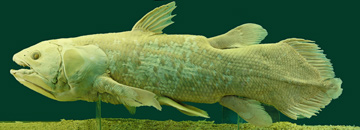100108LivingFossil.jpg

A preserved specimen of a coelacanth. Credit: http://commons.wikimedia.org/
If beauty really is in the eye of the beholder, then Marjorie Courtney-Latimer must have had the most discriminating eye in all of South Africa. On December 23rd, 1938, the museum curator in the town of East London spotted what she later called the most beautiful fish I had ever seen in the catch of a local trawler.
Most people might have considered the fish downright ugly. Its head was wide and stubby, and its skin was oily and slimy. Yet its scientific beauty was beyond compare. Although she didn’t know it until a few weeks later, Courtney-Latimer had discovered a living fossil — a fish that scientists thought had been extinct since the reign of the dinosaurs: a coelacanth.
Fossilized versions of the fish had been found in rock layers dating back as far as 400 million years, but none more recent than about 70 million years.
Courtney-Latimer’s fish was identified based on this fossil record. A second specimen turned up in 1952, and more followed. Then, in 1998, a second species of coelacanth was discovered thousands of miles away, in Indonesia.
The coelacanth didn’t just vanish and suddenly reappear, though. It’s been around for all those millions of years. But some biologists think that it has been relatively uncommon. And it hasn’t shown up in younger rock layers because it lived in ocean habitats where it was harder to make fossils.
Today, coelacanths are rare. But they live on — living fossils hiding in the depths of the sea.

